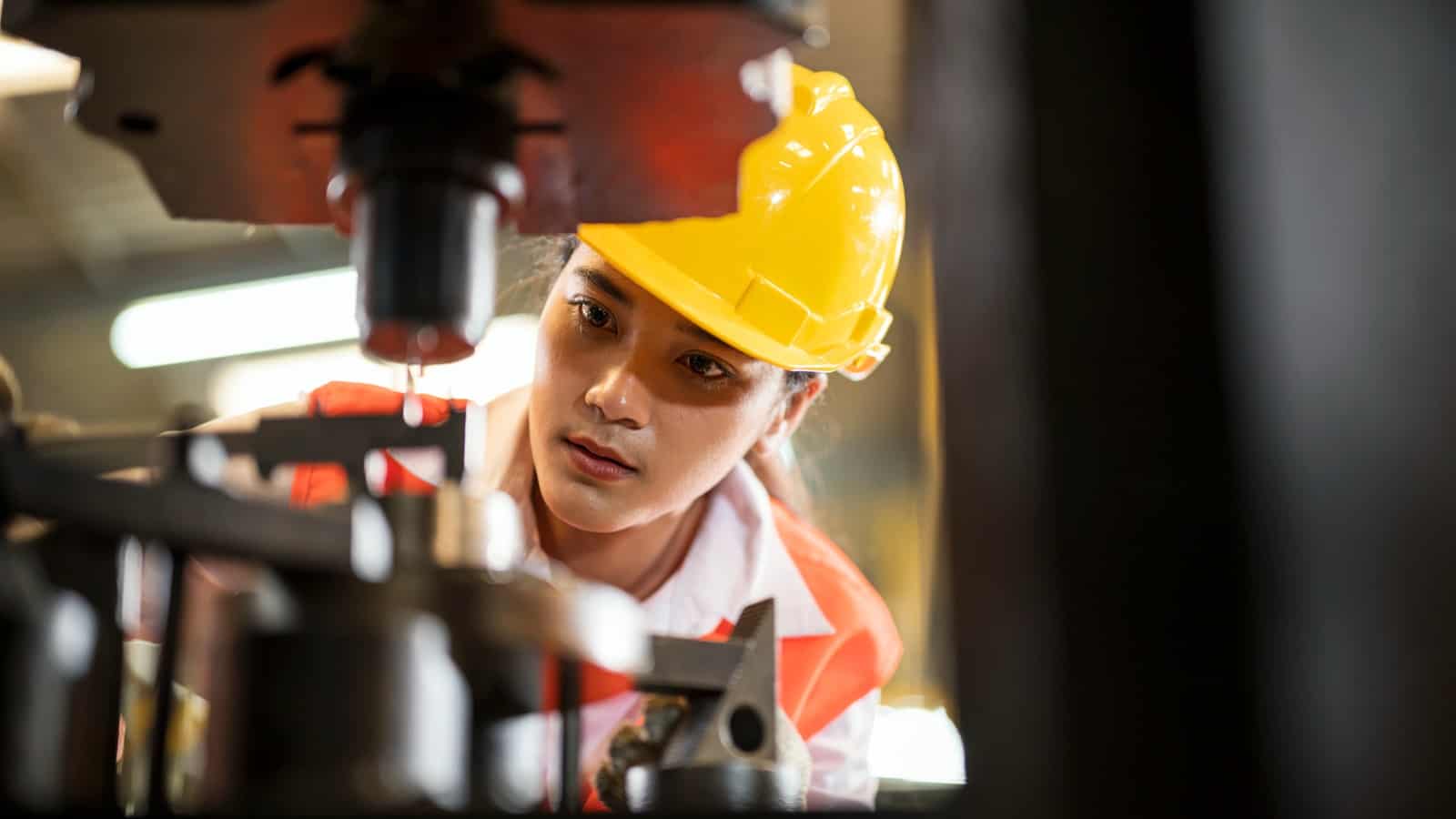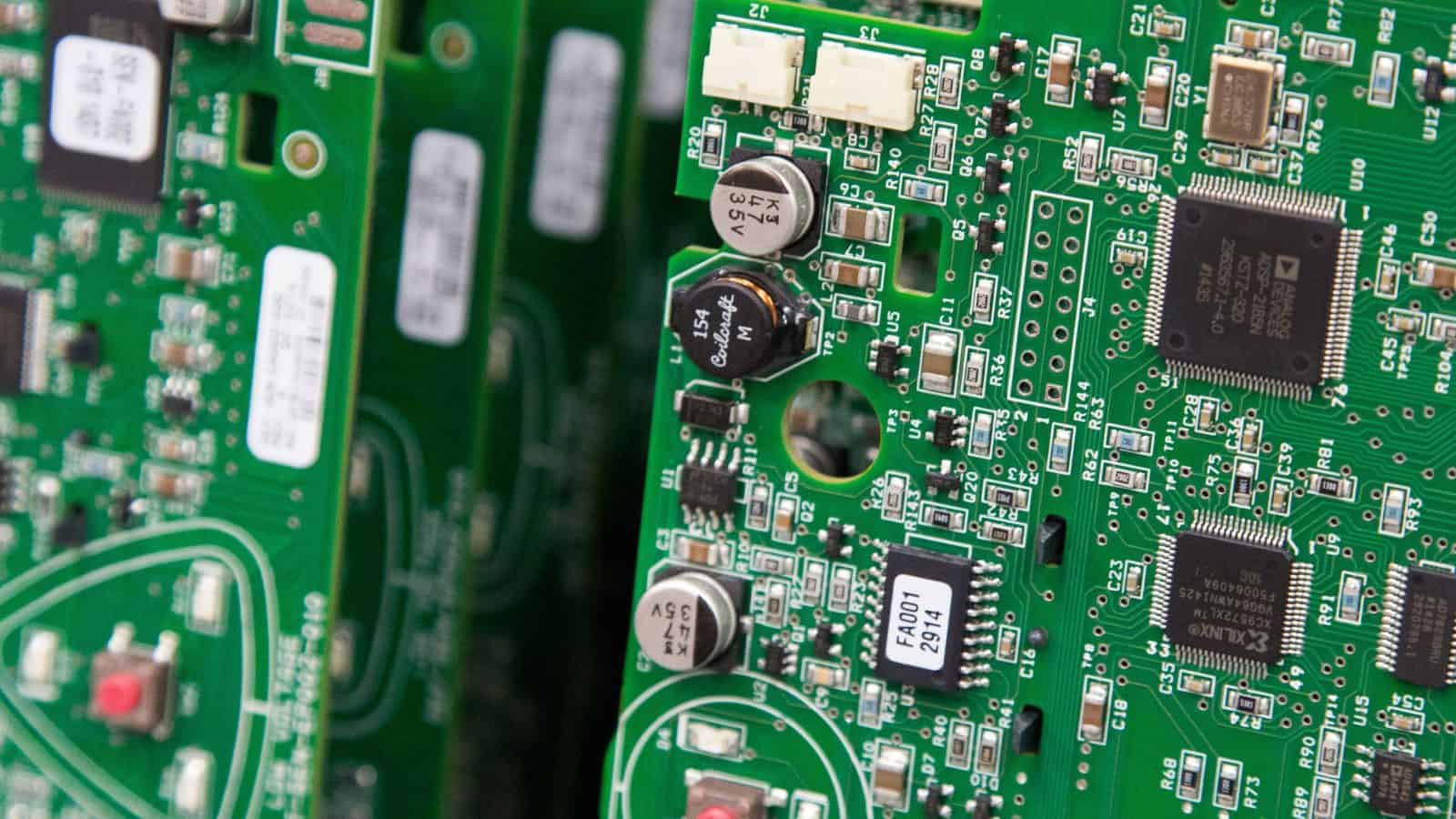Manufacturing in 2030: The Opportunity and Challenge of Manufacturing Data

As manufacturers move toward building smarter factories with connected machines, the data those systems produce can offer a host of benefits: improved efficiency, better productivity, informed decision-making, value creation and, ultimately, competitiveness. Yet becoming a data-driven business comes with its share of challenges. In this year’s Manufacturing in 2030 Survey, Data Mastery: A Key to Industrial Competitiveness, the NAM’s Manufacturing Leadership Council sheds light on the successes and opportunities for how manufacturers are transforming their operations with data.
Security and privacy concerns: As factories become more connected, cybersecurity becomes a greater imperative. For this reason, survey respondents validated that both data security and data privacy are essential.
- More than 90% of respondents have a formal or partial policy on data security and data privacy.
- About two-thirds of manufacturers have a formal or partial policy on data quality.
- More than 60% have a corporate-wide plan, strategy or guidelines for data management, but only 15% follow the plan in its entirety.
How data is used: As manufacturers advance along their M4.0 journey, data is becoming their lifeblood, driving insights and decision-making. Yet the survey revealed a gap between available data sources and their utilization, a notable area for improvement as the industry looks toward the future.
- Spreadsheets are still king: 70% of manufacturers enter data to them manually, and 68% still use them to analyze data.
- 44% of manufacturing leaders say the amount of data they collect is double what it was two years ago, and they anticipate it will triple by 2030.
- While nearly 60% of manufacturers use data to understand and optimize projects, there is a shift toward using data to make predictions about operational performance, including machine performance, in the next decade.
Business impact: Most manufacturers leverage data to find ways to save money or promote business growth. However, less than half have a good understanding of the dollar value of their data.
- Only about 25% of manufacturers have high confidence that the right data is being collected.
- Most manufactures have only moderate confidence in their analytic capabilities.
- Top challenges include data that comes from different systems or in different formats (53%), data that is not easy to access (28%) and lack of skills to analyze data effectively (28%).
- However, despite those challenges, 95% of manufacturers say data makes for faster and/or higher-quality decision-making.
The bottom line: An overwhelming majority of manufacturers (86%) believe that the effective use of manufacturing data will be “essential” to their competitiveness. But to realize data’s potential, manufacturers must figure out how to organize and analyze their data effectively, ensure that their data is trustworthy and align their business strategy closely with their data strategy.
Explore the survey: Get a deeper look at the current state of data mastery in manufacturing. Click here to download your copy.
NAM, Partners Urge Administration to Withdraw “March-in” Proposal

If finalized, guidance proposed last year by the Biden administration to allow the federal government to seize manufacturers’ intellectual property rights would be ruinous to the U.S. innovation economy, the NAM and state partners told Commerce Secretary Gina Raimondo this week.
What’s going on: In December, the Biden administration issued a proposal to enable government agencies to “march in” and revoke companies’ patent exclusivity if a product’s development was funded in any part by federal research dollars.
- Under the proposal, the government’s decision of whether to march in would be based on a product’s price—effectively imposing government-mandated price controls on innovative products like clean energy solutions, next-generation semiconductors and lifesaving medicines.
Manufacturers fight back: The NAM and a coalition of regional and state manufacturing associations are pushing back, highlighting the importance of ironclad IP rights to groundbreaking innovation.
- “[T]urning groundbreaking R&D into innovative products for the American people is only possible if creators—from university researchers to early-stage entrepreneurs to established businesses—can rely on strong intellectual property protections,” the associations told Raimondo.
Small business impacts: Startups and small businesses would pay the heaviest toll if the new march-in standards are finalized.
- Scientists and researchers at universities nationwide will face difficulties in partnering with the industry and in founding startups based on their research, “strik[ing] a blow to the local economies in [all 50] states that depend on university-centered innovation hubs for job creation and economic growth.”
- If a promising idea makes it out of the lab, outside investors will be reluctant to inject the capital necessary for further R&D and product development—resulting in fewer life-changing and lifesaving products for the American people.
What needs to happen: Manufacturers are calling on the Biden administration to reverse course.
- “We urge you to protect our local, state and regional economies, which benefit from breakthrough research, entrepreneurship and modern manufacturing, by withdrawing the proposed march-in guidance.”
10th Anniversary of NAM President and CEO’s “Four Pillars” Speech

NAM President and CEO Jay Timmons delivered a defining speech at the Friends of Adam Smith Awards a decade ago. This speech outlined the “Four Pillars of an Exceptional America,” a framework that continues to shape the NAM’s mission and advocacy.
Flashback: On June 11, 2014, in his speech accepting the 2014 Business Citizen Award for an outstanding record of achievement in advancing the principles of free enterprise, Timmons introduced the four pillars that underpin American exceptionalism and manufacturing strength.
The Four Pillars:
- Free enterprise: The economic system that unleashes innovation, creates opportunity and lifts humankind out of poverty more than any other economic system has in the history of the world.
- Competitiveness: Our ability, when untethered from government overreach, to prosper and win in a global economy.
- Individual liberty: The unique freedoms enshrined in our Constitution and Bill of Rights that enable us to live and succeed.
- Equal opportunity: Our shared belief that we all have the ability to contribute to the betterment of our families, our companies, our communities and our country.
Manufacturers’ approval: The NAM Board of Directors unanimously adopted these pillars as part of the association’s official policy positions, guiding the NAM’s Competing to Win agenda to bolster the competitiveness of manufacturers in the United States.
The impact: These pillars have guided the NAM’s efforts in promoting policies that support a robust manufacturing industry and a strong national economy, helping to draw support across the political divide for manufacturers’ principles-based agenda.
The bottom line: “The Four Pillars are not just about manufacturing; they are about sustaining the promise of America,” said NAM Executive Vice President Erin Streeter. “That’s why these values have helped us ensure the manufacturing agenda is a post-partisan agenda, drawing support for so many of our priorities from policymakers and by candidates—on both sides of the aisle—on the campaign trail. We will continue to work with anyone who wants to advance these values.”
Announcing the Winners of the 2024 Manufacturing Leadership Awards

The names are in! The Manufacturing Leadership Council—the NAM’s digital transformation division—is pleased to announce the winners of the 2024 Manufacturing Leadership Awards.
Now in its 20th year, the awards competition recognizes outstanding manufacturing companies and their leaders for groundbreaking use of advanced manufacturing technology.
“The class of 2024 should indeed be proud of their achievements in advancing the digital model of manufacturing,” said MLC Founder, Vice President and Executive Director David R. Brousell. “The awards reflect the truly incredible amount of innovation taking place in all sectors of the industry.”
Manufacturing Leader of the Year: Cooley Group President and CEO Daniel Dwight is the 2024 Manufacturing Leader of the Year.
- Dwight, who also serves on the MLC’s Board of Governors and is a member of the Executive Committee of the NAM Board of Directors, has overseen a significant turnaround in Cooley’s business performance through digital transformation, with a commitment to investing in smart factory technologies and developing a digital-ready workforce and business culture.
- In addition, the MLC named Cooley Group the 2024 Small/Medium Enterprise Manufacturer of the Year.
Large Enterprise Manufacturer of the Year: Intertape Polymer Group is the 2024 Large Enterprise Manufacturer of the Year.
- The award recognizes IPG’s achievements in digital transformation, including technology integration and workforce training.
- The company has also made noteworthy strides in sustainability through reductions in both energy usage and waste.
More honors: The MLC also announced winners in 11 project and individual categories, as well as the winners of the Manufacturing in 2030 Awards. The latter are given to projects with particularly forward-thinking innovations.
- The MLC honored all finalists and winners at the Manufacturing Leadership Awards Gala last night in Marco Island, Florida. A complete list of finalists and winners is available here.
Nominations for the 2025 season of the Manufacturing Leadership Awards will open on Sept. 16, 2024. More information is available here.
Rio Tinto Seeks to Meet Growing Copper Appetite

The demand for copper is skyrocketing—and global mining company Rio Tinto is powering forward full throttle to meet it (CNBC).
What’s going on: “The red metal, considered a barometer for economic health, is a vital component for the construction and defense industries as well as a key component in electric cars, wind turbines and the power grid.”
- However, current mines and in-the-works projects “will meet only 80% of copper needs by 2030, according to the International Energy Agency.”
- “There’s this growing consensus that demand fueled by the energy transition is going to outstrip supply, and that’s why analysts say we are simply not going to have enough of it,” said CNBC Markets Reporter Pippa Stevens in a recent CNBC video. “And copper really is the backbone of decarbonization goals.”
The challenges: Copper mining is difficult and expensive—and it takes 10 to 15 years to build each mine, Rio Tinto CEO Bold Baatar told CNBC.
A beneficial metal: Copper is the most economical conductor available, and directly and indirectly, it supports more than 395,000 U.S. jobs and more than $160 billion in economic output.
Behind the scenes: CNBC went behind the scenes at Rio Tinto’s Kennecott operations in Utah, where “about 200,000 metric tons of copper are produced annually.”
- There, Rio Tinto is increasing its open-pit mining operations and has started an underground project to mine higher-grade ore.
- Kennecott is unique for its smelter and refinery, “where the ore is processed into almost pure copper.”
Permitting challenges: Another of Rio Tinto’s projects, the Resolution Copper mine in Arizona, has the potential to power up to 25% of U.S. copper demand—but it has been mired in a regulatory morass for the better part of two decades.
- “The last hard-rock mine that was permitted was in 2008,” Rio Tinto Copper Chief Operating Officer Clayton Walker told the news outlet. “We’ve been working on the Resolution Mine for about 18 years.”
Independence is possible: “Theoretically, there are enough reserves in the U.S. that we could become independent for our copper needs,” Walker continued. “It’s just, how do we do that? How do we get the permits?”
What the NAM is doing: The NAM has been engaging directly with the Biden administration and members of Congress through meetings and briefings at NAM headquarters to push for comprehensive permitting reform.
- In addition, the NAM, along with members of the NAM’s Council of Manufacturing Associations and Conference of State Manufacturers Associations, last summer launched Manufacturers for Sensible Regulations, a coalition that seeks to speed up the frequently slow, arduous federal permitting process for energy infrastructure projects and address the large number of regulations being churned out by the federal government.
NAM to Senate: Administration March-in Proposal Undermines IP, Innovation

The Biden administration’s push to invoke “march-in” rights is unlawful and would have “disastrous consequences” for the United States if enacted, the NAM told the Senate Tuesday.
What’s going on: Ahead of a Senate Judiciary Committee hearing on intellectual property in the biopharmaceutical sector, the NAM warned of the potentially dire consequences of the proposed march-in framework issued by the National Institute of Standards and Technology.
- The NIST proposal would allow the federal government to “march in” and seize manufacturers’ patent rights if an innovation was developed in any part with federal dollars.
- In the biopharmaceutical sector and other innovative industries, federal funding plays an important role in supporting early-stage research—but further R&D, product development and commercialization require hundreds of millions to billions of dollars in additional capital from investors and established companies.
- Robust IP protections ensure that manufacturers can bring innovative products to consumers.
Why it’s a problem: March-in would violate manufacturers’ IP rights and prevent investment into lifesaving and life-changing technologies, according to NAM Vice President of Domestic Policy Charles Crain.
- “Allowing march-in based on the price of a product or technology, as the NIST guidance proposes … would undermine manufacturers’ IP rights and have sweeping ramifications for innovation in the United States and America’s world-leading innovation economy,” Crain told the committee.
- Committee member Sen. Chris Coons (D-DE) agreed during the hearing that the proposal is fundamentally flawed. “Any company [that] invents [anything] or any researcher who invents anything is now open to the federal government saying, ‘I want that, and I don’t agree with the price you’re setting for it,’” he said.
What should happen: Congress must stop NIST’s overreach, Crain said.
- “Policies that threaten IP protections, like NIST’s proposed march-in guidance, will cede one of our greatest advantages to our competitors. Manufacturers [look forward] to work[ing] with the committee to ensure the U.S. maintains the strongest IP protections in the world in order to spur the discovery and commercialization of inventions that improve health and quality of life for all people.”
NAM Publishes First-of-Its-Kind Report on Vast Potential of Artificial Intelligence for Manufacturers
Washington, D.C. – The National Association of Manufacturers released a first-of-its-kind report, “Working Smarter: How Manufacturers Are Using Artificial Intelligence,” detailing use cases for artificial intelligence in manufacturing and case studies of how manufacturers are already implementing AI technologies to strengthen America’s workforce, advance innovation and improve the quality of life for everyone.
The report provides an overview of insights from leading manufacturers, including Johnson & Johnson, Schneider Electric and Hitachi, on how AI can improve efficiency, product development, safety, predictive maintenance and supply chain logistics. The report also outlines a series of recommendations on how policymakers can help support the safe, responsible development of AI while promoting innovation and growth.
“So much of the media and policymaking conversation is focused on generative AI, but AI is far more than that for modern manufacturers,” said NAM President and CEO Jay Timmons. “It’s infused increasingly throughout the shop floor, research and development and beyond. Manufacturers are leading the way in the use and development of new AI technologies. From developing more effective clinical trials and improving workplace safety to strengthening supply chain resiliency and supporting workforce training for employees, AI is unlocking new opportunities to strengthen our modern manufacturing workforce and improve the lives of all Americans. Congress and the Biden administration can support manufacturers’ adoption of AI by enacting strong data privacy protections, investing in workforce training and providing regulatory certainty.”
“All possible futures for modern manufacturing in the U.S. involve AI,” said Johnson & Johnson Executive Vice President and Chief Technical Operations & Risk Officer and NAM Board Chair Kathy Wengel. “Given the importance of this generational technology, policymakers must develop sensible, carefully thought-out frameworks for various AI applications—and they should lean on manufacturers’ years of experience to engineer those frameworks. We need a policy environment that supports innovation and growth in manufacturing AI, because it will bolster U.S. competitiveness and leadership in this critical emerging field.”
Policy recommendations include the following:
- Invest in R&D and career technical education institutions that train the modern manufacturing workforce.
- Enact federal privacy legislation that advances individuals’ privacy and provides legal clarity that supports continued innovation and competitiveness.
- Employ a risk-based approach that tailors any new AI regulations—only if new regulations are necessary—to specific use cases and minimizes compliance burdens.
- Ensure that regulatory frameworks are aligned globally to maintain U.S. global leadership. The more disparate the approach to AI around the world, the more time, energy and investment companies will need to spend navigating misalignments.
Learn more here.
-NAM-
The National Association of Manufacturers is the largest manufacturing association in the United States, representing small and large manufacturers in every industrial sector and in all 50 states. Manufacturing employs nearly 13 million men and women, contributes $2.89 trillion to the U.S. economy annually and accounts for 53% of private-sector research and development. The NAM is the powerful voice of the manufacturing community and the leading advocate for a policy agenda that helps manufacturers compete in the global economy and create jobs across the United States. For more information about the NAM or to follow us on Twitter and Facebook, please visit www.nam.org.
NAM First-of-Its-Kind AI Report Includes Policy Recommendations

Artificial intelligence is improving efficiency, workplace safety, product development, machine maintenance and supply chain logistics at manufacturing facilities everywhere, according to a new, first-of-its-kind report from the NAM.
What’s going on: “Working Smarter: How Manufacturers Are Using Artificial Intelligence,” released today, details use cases for AI in the sector, discussing how manufacturers nationwide are using it to improve lives everywhere.
- The report features deep dives on AI-powered technologies at manufacturers, including Johnson & Johnson, Schneider Electric and Hitachi.
Trailblazers need good policy, too: “From developing more effective clinical trials and improving workplace safety to strengthening supply chain resiliency and supporting workforce training for employees, AI is unlocking new opportunities to strengthen our modern manufacturing workforce and improve the lives of all Americans,” said NAM President and CEO Jay Timmons. “Congress and the Biden administration can support manufacturers’ adoption of AI by enacting strong data privacy protections, investing in workforce training and providing regulatory certainty.”
- Legislators should “lean on” manufacturers’ deep experience when drafting AI-related legislation, added Johnson & Johnson Executive Vice President and Chief Technical Operations & Risk Officer and NAM Board Chair Kathy Wengel.
- “All possible futures for modern manufacturing in the U.S. involve AI,” she said. “Policymakers must develop sensible, carefully thought-out frameworks for various AI applications. … We need a policy environment that supports innovation and growth in manufacturing AI, because it will bolster U.S. competitiveness and leadership in this critical emerging field.”
The recommendations: The report contains immediately implementable policy recommendations for lawmakers:
- Invest in research and development and career technical education institutions to train the modern manufacturing workforce.
- Pass federal privacy legislation to advance individuals’ privacy protections and give legal clarity that will support continued innovation by manufacturers.
- Use a risk-based approach to new AI regulations that tailors any future laws to specific use cases and minimizes the burden of compliance.
- Ensure that AI regulation is aligned globally.
IRI Announces 2024’s Top Innovator Finalists

The Innovation Research Interchange has announced the finalists for this year’s IRI Innovation Excellence Awards.
What’s going on: The honors given by the IRI—the NAM’s innovation arm—pay tribute to organizations and individuals whose outstanding vision and tireless pursuit of excellence are having a positive impact on lives today and shaping the industries of tomorrow. Honorees come from companies of all sizes and industries.
The categories: Awards are given in five categories, three to companies and two to individuals. They are as follows:
- IRI Innovation Leadership Award (individual)
- IRI Promising Young Innovation Professional Award (individual)
- IRI Excellence Award for Innovation in Sustainability (company)
- IRI Excellence Award for Outstanding Innovative Culture (company)
- IRI Excellence Award for Digital and Technological Innovation (company)
Who participates: Each year, nominees comprise innovators who are leveraging technology to enhance operational performance at their companies or sustainability and fostering a collaborative workplace culture that celebrates innovation.
- High-performing leaders who drive sustainability initiatives are also recognized, and consultants and university partners working on exciting innovation projects with a company are eligible for nomination, too.
Why they’re important: In addition to building team unity and encouraging executive leadership to invest further in innovation, the awards give companies the chance to revisit the successes, challenges and lessons learned throughout their innovative projects.
- Selection as a finalist shows customers, prospects and partners that a company or individual is at the forefront of innovation.
Attend the celebration: Winners will be announced May 16 during the Innovation Celebration and Reception at the Innovators Summit in Boston. Celebration admission is included with summit registration.
About the IRI: The IRI offers insights, case studies, research, benchmarks and strategic connections—all built around a set of innovation growth drivers as determined by members annually. Learn more about the IRI here.
Proposed “Right-to-Repair” Exemptions Would Hurt Manufacturers, Consumers

The NAM testified before the U.S. Copyright Office last week, explaining how two proposed exemptions from copyright protections would weaken manufacturers’ intellectual property rights, do significant harm to their businesses and potentially endanger consumers.
What’s going on: The Copyright Office is considering whether to recommend two exemptions from the Digital Millennium Copyright Act that would allow users to circumvent measures protecting copyrighted content.
- One proposal was designed to allow the so-called “right-to-repair” by enabling access to operational data (including diagnostic and telematics data) from automobiles, agricultural vehicles, marine vessels and more. The other is focused on industrial equipment.
NAM speaks out: “The basis of the so-called ‘right-to-repair’ movement hinges on the false notion that owners do not have the ability to repair their own equipment,” NAM Vice President of Domestic Policy Charles Crain said at the recent hearing. “The truth, however, is that the majority of [original equipment manufacturers] already provide a wide range of resources and tools that allow users—and third-party repair businesses—to maintain, diagnose and repair products.”
- The NAM previously submitted comments urging the Copyright Office not to adopt the proposed exemptions.
Why it’s important: “These exemptions would undermine manufacturers’ IP rights in service of right-to-repair—and the record does not support their adoption,” Crain continued.
- The exemptions are too broad and inadequately defined, and their proponents have “failed to show that users will be adversely affected absent the ability to circumvent [copyright law].”
- What’s more, the exemptions “would expose proprietary information to public consumption and use, likely endangering consumers and allowing for unlawful modifications of government-mandated safety and emissions limits.”
The last word: “In short, right-to-repair is a solution in search of a problem,” Crain said.
